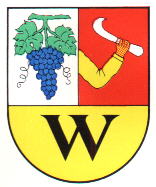Waldulm: Difference between revisions
Knorrepoes (talk | contribs) No edit summary |
Knorrepoes (talk | contribs) m (Text replace - "[[Literature" to "{{media}} [[Literature") |
||
| Line 20: | Line 20: | ||
The oldest seal of Waldulm dates from the early 19<sup>th</sup> century and shows more or less the later arms. The upper right field, however, is not clearly seen on all available stamps. Later in the 19<sup>th</sup> century the upper right field is shown with a bee, instead of the grape. When the present arms were granted in 1913 it was stated by the major that the arms should contain a grape and not a bee. The upper part symbolises the importance of the viticulture in the area, the lower part is the initial of the village. | The oldest seal of Waldulm dates from the early 19<sup>th</sup> century and shows more or less the later arms. The upper right field, however, is not clearly seen on all available stamps. Later in the 19<sup>th</sup> century the upper right field is shown with a bee, instead of the grape. When the present arms were granted in 1913 it was stated by the major that the arms should contain a grape and not a bee. The upper part symbolises the importance of the viticulture in the area, the lower part is the initial of the village. | ||
{{media}} | |||
[[Literature]] : Zier, 1964. | [[Literature]] : Zier, 1964. | ||
Revision as of 08:47, 9 July 2014
| Heraldry of the World Civic heraldry of Germany - Deutsche Wappen (Gemeindewappen/Kreiswappen) |
WALDULM
State : Baden-Württemberg
District (Kreis) : Ortenaukreis (until 1972 Bühl)
Incorporated into : 1974 Kappelrodeck
Official blazon
In geteiltem und oben gespaltenem Schild vorne in Silber eine blaue Traube mit zwei grünen Blättern, hinten in Rot ein aus der Spaltung herausragender golden gekleideter Arm, der ein silbernes Winzermesser hält, unten in Gold der schwarze Großbuchstabe W.
Origin/meaning
The arms were adopted in June 1913.
The oldest seal of Waldulm dates from the early 19th century and shows more or less the later arms. The upper right field, however, is not clearly seen on all available stamps. Later in the 19th century the upper right field is shown with a bee, instead of the grape. When the present arms were granted in 1913 it was stated by the major that the arms should contain a grape and not a bee. The upper part symbolises the importance of the viticulture in the area, the lower part is the initial of the village.
Contact and Support
Partners:
Your logo here ?
Contact us
© since 1995, Heraldry of the World, Ralf Hartemink 
Index of the site
Literature : Zier, 1964.











